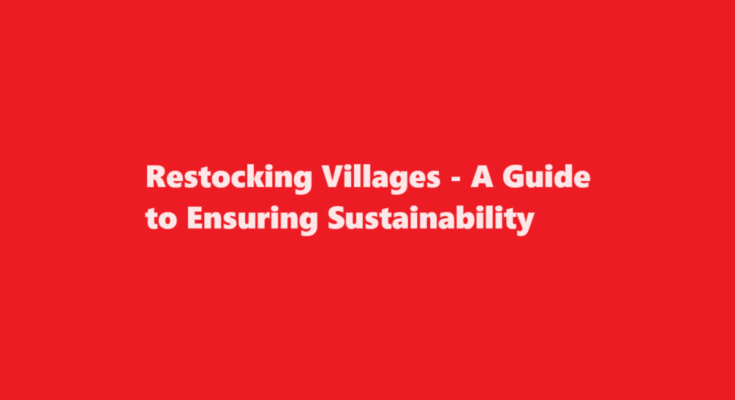Introduction
In many rural communities around the world, the concept of restocking is vital for maintaining the well-being of the villagers. Villagers heavily rely on their local resources, whether it’s for agriculture, fishing, or other livelihoods. Ensuring these resources are sustained and replenished is crucial for the long-term health and prosperity of the community. This article aims to explore various strategies and methods for getting villagers to restock effectively.
Education and Awareness
One of the first steps in encouraging villagers to restock their resources is education and raising awareness. Many villagers might not fully understand the importance of resource sustainability. Providing information on the benefits of restocking, the potential consequences of overexploitation, and simple ways to restore resources can be eye-opening.
Community workshops, awareness campaigns, and school programs can be used to inform villagers about the ecological and economic value of restocking. When people understand the consequences of depleting their resources, they are more likely to take steps towards restocking.
Implement Sustainable Farming and Fishing Practices
Sustainable practices are the cornerstone of successful restocking initiatives. In agriculture, promoting crop rotation, using organic farming techniques, and avoiding overuse of pesticides can help rejuvenate the soil and increase crop yields. In fisheries, encouraging selective harvesting and implementing no-take zones can help fish stocks recover. By incorporating sustainable methods, villagers can ensure a continuous supply of food and other resources.
Community-Based Resource Management
Community-based resource management involves the active participation of villagers in decision-making processes related to resource management. Villagers play a significant role in determining fishing or farming regulations and actively participate in enforcing these rules. This ensures that resources are used sustainably and that overexploitation is minimized.
Community-based management systems promote a sense of ownership and responsibility among villagers, making them more likely to restock resources for the benefit of the entire community.
Establishing Cooperatives
Cooperatives can be instrumental in restocking efforts. Villagers can form cooperatives to pool resources and jointly invest in restocking initiatives. For instance, a cooperative can purchase and distribute high-quality seeds or fingerlings for farming or fish ponds. This collaborative approach not only reduces the financial burden on individual villagers but also fosters a sense of unity and shared responsibility.
Government Support and Incentives
Government support can be a game-changer in restocking villages. Governments can provide financial incentives, subsidies, or low-interest loans to villagers interested in adopting sustainable practices and restocking initiatives. These incentives can help villagers overcome financial barriers that might otherwise deter them from restocking.
Moreover, governments can also establish regulations and monitoring systems to prevent illegal or excessive exploitation of resources, ensuring that restocking efforts are not in vain.
Rehabilitation of Natural Habitats
The restoration of natural habitats is vital for many villages’ resource sustainability. Villagers can collaborate with local environmental organizations and government agencies to restore ecosystems that have been damaged due to human activities. Planting trees, restoring wetlands, and creating artificial reefs are all effective ways to rejuvenate habitats that support agriculture and fisheries.
Training and Skill Development
Providing villagers with training and skill development opportunities is essential for successful restocking. Training programs can cover a range of topics, from sustainable farming techniques to responsible fishing practices. These programs empower villagers with the knowledge and skills needed to effectively restock and manage resources.
Monitoring and Evaluation
Regular monitoring and evaluation are crucial for assessing the progress and effectiveness of restocking efforts. Villagers, with the support of government agencies or non-governmental organizations, should collect data on resource availability and health. This data can help track the success of restocking initiatives and identify areas that require improvement.
Collaboration with NGOs and International Organizations
Collaboration with non-governmental organizations (NGOs) and international organizations can provide valuable support for villagers. NGOs often have expertise in sustainable resource management and can offer technical assistance, funding, and access to global networks. Villagers can benefit from such partnerships by gaining access to resources and knowledge that they might not have had otherwise.
Encourage Sustainable Tourism
For many villages, sustainable tourism can be an additional source of income that supports restocking efforts. By promoting eco-friendly tourism, villages can attract visitors who are willing to contribute to local conservation and restoration projects. Revenue generated from sustainable tourism can be reinvested in restocking initiatives, creating a virtuous cycle of resource protection and economic growth.
FREQUENTLY ASKED QUESTIONS
Why won’t my villagers restock?
They need to have their job specific workstation right in front of them. If you have them in a boat or minecart, put them in a room and let them free with their workstation. They only work at midday (the sun will be right above your head). As I said if you are in an older version just update it to the latest version.
Can a cured villager restock?
Villagers will not restock their trades after they are cured from being a zombie villager. and before the zombie villager they were traded with. Before curing the villagers I tested with, they restocked fine. I first encountered it on a server I was playing with friends.
Conclusion
Ensuring the sustainability of village resources through restocking is a complex but essential task. By educating villagers, promoting sustainable practices, establishing community-based management systems, and seeking government support, villages can increase their chances of long-term success. Collaboration with NGOs and international organizations, as well as the promotion of sustainable tourism, can further enhance these efforts. Through a combination of these strategies, villagers can restock their resources effectively and secure a brighter, more sustainable future for their communities.
Read Also : A Step-by-Step Guide to Canceling AppleCare – Simplifying The Process



